Yan Zhenqing's regular script "The Story of Magu's Fairy Altar (麻姑仙坛记)" is a comprehensive guide!
"The Story of Magu's Fairy Altar (麻姑仙坛记)" was written by Yan Zhenqing when he was 63 years old. During this period, Yan Zhenqing lived far away from the rivers and lakes. Perhaps he temporarily forgot about political disturbances, being close to nature, and going out of Buddhism, which made his calligraphy less complex. Stern and solemn, but a little more desolate and natural. There are very few small prints in Yan Zhenqing's handwritten relics. "The Story of Magu's Fairy Altar (麻姑仙坛记)" gives us a glimpse of his fine print style. Those who have traditionally used lower-case letters often take Zhong Yao's Puzhuo No. 1 or Wang Xizhi's No. 1 of Xiuya, while Yan Zhenqing's lower-case letters provide a new style of paradigm, which is flat and broad. The characters are small and spaced, but they still do not lose their momentum. Ouyang Xiu commented that Yan Zhenqing's small characters are "respectful in style, comfortable and not frowned upon", which is completely consistent with the style and characteristics of regular script in large characters. Wang Shu of the Qing Dynasty said: "In the book of Yan Lu Gong, the big one has nothing to do with "Ode to Zhongxing (中兴颂)", and the small one has nothing to do with "Ma Gu Altar.(麻姑坛)" Although the size is different, the spiritual structure is the same. Big, "Ma Gu (麻姑)" is not a small one, so Yu Yan Shu thinks more than half of it." The "Zhongyi Tang Tie (忠义堂帖)" is slightly thinner than the smaller version, and the structure is slightly tighter. It is less heavy and more elegant. Learn lower script Those who take this approach, should pay more attention to experience, will be able to have more enlightenment and harvest.
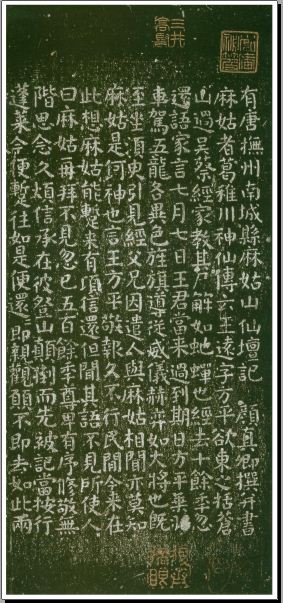
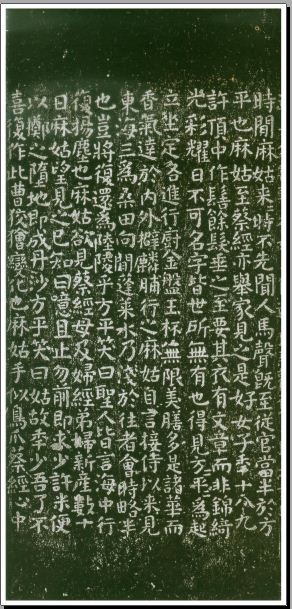
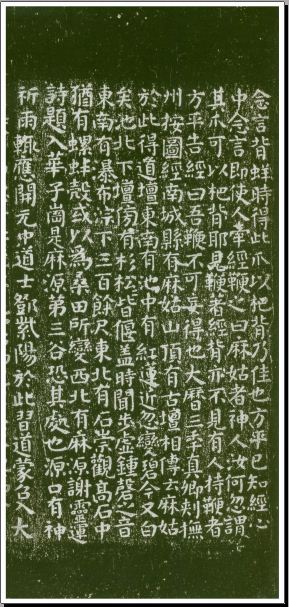
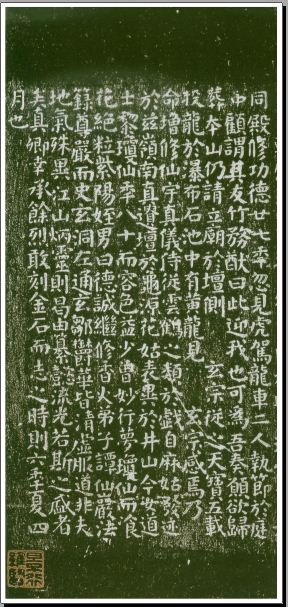
Rubbings of Small Characters of "The Story of Magu's Fairy Altar (麻姑仙坛记)"
"The Story of Magu's Fairy Altar (麻姑仙坛记)" is a model work in history and one of the excellent models for us to learn regular script. Below, we will analyze the characteristics of the various strokes and structures of "The Story of Magu Fairy Tale" in order to further help you to write (please refer to the large-character rubbings).
1. Stroke characteristics of "The Story of Magu's Fairy Altar (麻姑仙坛记)"
颜真卿书法作品众多,风格多样,绝少雷同,但总体上都表现出雄厚、庄重、郁勃的风貌。《麻姑仙坛记》的用笔以篆法入楷,骨力挺拔,起笔、收笔多藏头护尾,精力内蕴,含而不露。
1. The characteristics of stippling
Dot is an important stroke that constitutes Chinese characters. Many strokes come out from the dot and close by the dot. The dot is called "side" in the "Eight Laws of Yongzi". It is called "side" because the front of the pen looks at the left and looks at the right and examines its momentum. Wang Xizhiyun: "If a little is lost, if the beauty enters the disease at a glance;-a painting is lost, like a strong man's dazzling." Accumulating points into a painting, accumulating pictures into characters, accumulating words into articles, so you can see, you must learn calligraphy, You must first learn the points well.
The writing style of dot painting in "The Story of Magu's Fairy Altar (麻姑仙坛记)" is varied, with square, round, long, horizontal, oblique, and picking in many types, but each painting is full of vigor, echoing Zhuanghe. The dot on the right is the most used one of the monuments, and the dot on the word "zi" in the figure below. This kind of stippling is like melon seeds, polished and rounded, like dew drops, full of tension and beauty. Sometimes, the point is slightly curved to show softness. The point on the left is a unique stippling in the stele. Its position is the same as the point on the right, and it is farther from the center of the character, which fully reflects the characteristics of the internal and external tightness of the Yan character. Click to the left of the word "less" in the figure below. The dots in "The Story of Magu's Fairy Altar (麻姑仙坛记)" are varied. In the figure below, the initial dot of "被" is replaced by a short horizontal dot. The upper dot of the word "Ma" becomes a vertical dot, and the lower left dot of the word "yi" becomes a pick dot. . Even if it is the same Zengtou point, there are endless changes in the monument. The two points on the word "di" in the figure below are written as "八". This is the general writing of Yan, and this monument is no exception; but "and" The two points on the character are written as two small strokes, one is sharp and the other is blunt; when it comes to the character "beauty", it changes to "sheep head method". This is to draw lessons from the seal method to make the characters more vivid. . When there are three points together, it is replaced by three small straight parallels, as shown in the figure below for the word "Jing" with three points at the bottom left; and the right part of the character is written with two points on the top and bottom in the script intent to make the whole character It seems very smart. There are many different ways of writing the dot paintings in "The Story of Magu's Fairy Altar (麻姑仙坛记)". You must carefully observe and summarize them when you write them.
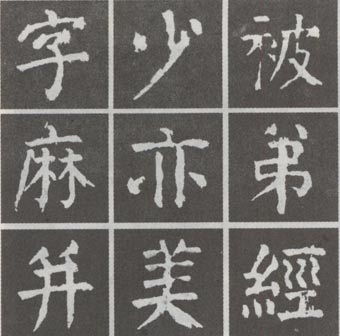
2. The characteristics of horizontal painting
Horizontal painting is called "Le" in the "Eight Methods of Yongzi", and it mainly serves as the skeleton of the character. Jiang Kuiyun of the Southern Song Dynasty: "The person who paints horizontally and vertically is the bones of the characters." Wang Xizhi also said about the writing of horizontal painting: "If it is straight and similar, like an operator, the top and bottom are straight, and the front and back are level, this is not a book, but it must It’s dot painting ears.” The horizontal paintings in "The Story of Magu's Fairy Altar (麻姑仙坛记)" are all oblique, low left and high right, but the angle is not large, square pens are often seen at the beginning of the pen, and round pens are mainly used to hide the front when the pen is closed. The horizontal paintings do not have the strong contrast of thickness and thickness as in the "Stele of Qin Li", but are carefully arranged with similar strokes, appearing calm and dignified. If there are several horizontal paintings juxtaposed in the same character, there will be no change between the left and right tips in the "Stele of Qin Li".
The changes in the horizontal painting in the stele are mostly seen in the process of pen writing. When writing, the tip of the pen is slightly jittery, not-it is slippery, flat and straightforward, and it needs to be slightly "house leak marks". The thickness is unpredictable, and the charm is endless. Suddenly the left side is thick, the right side is thick, and the middle is thick. Multi-horizontal characters, the horizontal strokes are evenly spaced from top to bottom, the left and right are uneven, and the lengths match, which are vivid and natural in the changes. In the picture below, the strokes of the character "ten" are divided into two lines, the strokes are flat and ten thousand cents of strength, so the strokes are very fine; the strokes under the character "hand" are heavy and thick, and the strokes are round and lighter. , Which forms a clear contrast with the short horizontal in the middle; while the characters "yan" and "王" have many horizontal paintings, but they are extremely varied, and there is no similarity. The strokes look heavy and thick. In general, the horizontal painting in "The Story of Magu's Fairy Altar (麻姑仙坛记)" starts slowly, and when moving the brush, the speed is appropriately faster than that of the brush in order to generate strength. These are the issues that should be paid attention to when writing the monument.

3. The characteristics of vertical painting
Vertical pictures play a pillar role in the structure of Chinese characters. The ancients said: "The vertical is like a long live withered vine." Therefore, the vertical occupies an important position in the knot. Because of the different positions of the vertical paintings in "The Story of Magu's Fairy Altar (麻姑仙坛记)", the strokes and strokes are also different: if they are on the left side of the character, they will bend to the left; if they are on the right side of the character, they will generally bend to the right. , In order to obtain the potential of external expansion. As shown in the picture above, the vertical painting of the character "Mountain" leans slightly to the left, and its shape is slightly curved to the left. In the picture above, the character "Chuan" in the middle is vertical and vertical. When the pen is lifted and pressed again, the center moves downward, and finally the pen is returned to the front. The pen is strong and vigorous, and the two vertical and vertical strokes stand side by side, so that the character has an indomitable state.
4. The characteristics of skimming
In the "Eight Laws of Yongzi", it is called "sweeping", which means flying swallows to sweep down the eaves. When it comes out, it must be smoothly deployed, but the strength must be sent, not to be false. Li Shimin, Emperor Taizong of Tang Dynasty, said: "To skim, we must plunder, it is expensive and dangerous." The drawing in "The Story of Magu's Fairy Altar (麻姑仙坛记)" is against the paper, and then he pauses the pen to follow the trend of the center, and gradually lifts it up, sending the end of the pen with composure. Vigorous, like the teeth of a broken rhinoceros, without the slightest weakness. In the picture below, the character "fang" is drawn using the seal and calligraphy method. When the pen is written, the pen is also laid and piled, and the strokes are strong and strong; while the character "claw" is short-handed and sharpened on both sides after the counter-front is started. The pen is fast and sharp; the word "big" is a long arc, with a well-proportioned arc. Muscles and bones are vigorous, tough, and heavy; the left-handed character of "Wei" is a return to front-handed, which is a more typical type of painting on the monument. Retract, continue to follow the momentum, press down to the left and round your feet and retreat. When the straight forward is straight and the momentum is full, use explosive force to overshoot to the left or upper left, making the front as sharp as a short spur.

5. The characteristics of painting
Na is called "磔" in the "Eight Laws of Yongzi". Bao Shichen of the Qing Dynasty said in "Yizhou Shuangxie": "Narrow the pen to the right, move the pen to the right, pave the front of the pen, try to disperse and send it out urgently." Three folds are sent to Bo." The paintings in "The Story of Magu Fairy Altar" are unique, and are quite different from those in Yan Zhenqing's other posts. The tail slap has the most varied changes. It seems to have two sharp points, one long and one short, with a concave middle. The waist of the strokes is sometimes slightly sideward, and the lower edge appears to be a broken line.
In the picture above, the word "AND" is drawn obliquely. This kind of arc is like a downward convex, sometimes there is a short straight line behind it, the stroke will gradually open downwards and the drawing will gradually become thicker, until two-thirds of the drawing is the thickest, and the stationary brush is slightly paused. Retracted, and then dragged forward to write, looking sophisticated and energetic. The painting of "Zhi" in the above picture is smooth, with twists and turns, "silkworm head and swallow tail", and the thickness and direction are adjusted according to the situation.
6, the characteristics of the sketch
The hook is called "趯" in the "Eight Laws of Yongzi", which means jumping. Wang Xizhiyun: "A hook is like a strong pine, falling down and hanging on a rock cliff." Qing Bao Shichen said: "The super hook is like a foot in the foot, its strength is not on the foot at the beginning, it is suddenly triggered, and the full force is on the toe, so The end of the hook must not be used as a drifting force to frustrate the front, it is also meaningless."
The hook paintings in "The Story of Magu Fairy Altar" are characterized by short and sharp hook tips, like a bird's beak. Some hooks are slightly out of the front, and some hooks simply do not. When writing hooks, we should also pay special attention to an important feature of the pen used on this stele-seal and ancient law. As shown in the figure below, the hooks of the characters "色", "護", and "求" are shown in the picture below.
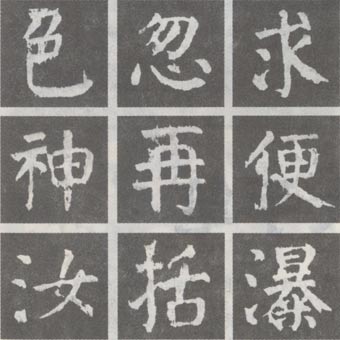
7, the characteristics of folding painting
Folding painting is a combination of horizontal painting and vertical painting. The key to writing this painting is to write the combination of the two brushes. The folding paintings in "The Story of Magu Fairy Tale" are dominated by round folds, with gentle folds, with little difference in thickness between horizontal and vertical. There are three main types: the first type is the character "God" in the above picture. The inside and outside of this fold is round, and it is completely written using seal script; the second type is the outside circle inside the square fold, as shown in the above picture. ; The third type is the word "convenience" in the picture above. The fold is divided into two strokes to complete. First, draw horizontally, and then start to write vertically when you reach the fold. The pen is broken between the two strokes.
8. The characteristics of picking paintings
Jiang Kui of the Southern Song Dynasty pointed out in the "Continued Book Pu": "Those who choose to challenge, the steps of the word, want it to be solid, longer, or shorter, or upward, or downward, or left, or right, or lightly out. On the other hand, Xiao Xian may be pronounced sharply with the nose, and the name follows the usefulness of the word." In "The Story of Magu Xiantan", there are many variations, but an obvious feature is that the stroke is heavier and the front is shorter, especially The picking paintings in "Three Points of Water" are more obvious, giving people a sharp and vigorous feeling. As shown in the picture above, the character "ru": picking pictures of the characters "Kuo" and "Waterfall".
2. The composition analysis of "The Story of Magu Fairy Tale"
Yan Zhenqing's "The Story of Magu Fairy Altar" is simple and simple, introverted and reserved, and blends the spirit of seal and calligraphy in the regular method. The lines are like long live withered vines. The knots are broad and generous. It is a combination of singularity and integrity. Complete, rich in content, and demeanor. In order to write "Mugu Xiantan Ji" well, in addition to a clear understanding of its stroke characteristics, it is also necessary to master its basic structure characteristics.
1. The structure is pressed down, moving in the static
The structure of each character in "The Story of Magu Fairy Tale" is extremely varied, but many of the characters have shifted their center of gravity. It makes people feel cute. In addition, the strokes of some characters are handled very well, which is full of wit and humor in the quiet. As shown in the figure below, the words "half" and "hua".
2. The four corners are fully braced and the ends are tight
"The Story of Magu's Fairy Tale" has an open style, full of squares and squares. The combination of strokes and strokes is uniform, rigorous and unremitting, stable and strong. As shown in the figure below, the words "pour" and "Cai".

3. Dignified and simple, combining cleverness in clumsy
Qing Fu Shanyun: "It is better to be clumsy than clever, rather ugly than charming, rather to be indifferent than slippery, rather than to arrange." This gives people a new aesthetic point of view in theory. However, Yan Zhenqing has long put this aesthetic concept into his calligraphy works. "The Story of Magu Xiantan" is a good example. For example, the characters "He" and "Ma" in the picture above, the brushwork that accumulates the power, the lines cast by melting seals, and the magnificent structure, all show its clumsy flavor. In addition, we can feel the breath of "smart" while savoring its "clumsy".
4. Shen Xiong body, magnificent weather
In "The Story of Magu Immortal Altar", every character has a magnificent body and a magnificent appearance. This is a mystery on the body of the stele. Especially in some characters with left and right structure, it does not emphasize interspersed, but on the contrary, try to make the left and right independent in posture, but form an artistic whole in expression, so that the monument is magnificent, round and old. . As shown in the picture above, the two words "yan" and "wei".








